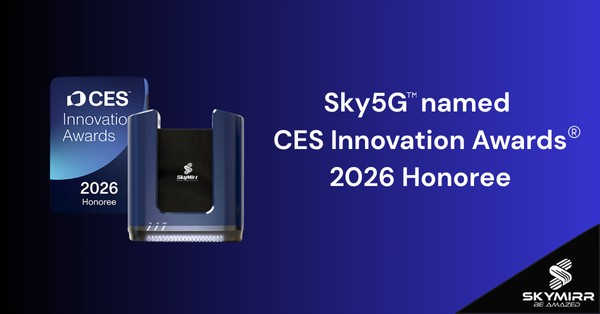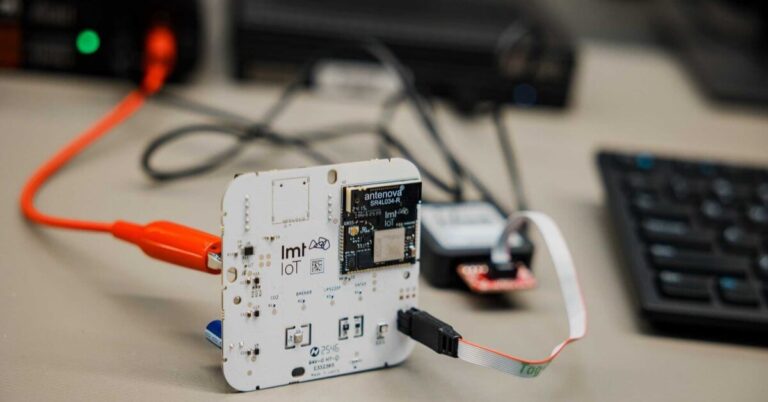CES 2026: Antenna-first 5G CPE strategy with SkyMirr Sky5G
SkyMirr’s Sky5G Wireless Router being named a CES 2026 Innovation Awards Honoree signals that antenna-first design is emerging as a decisive lever for 5G customer-premises equipment performance and reliability.
Why an RF-first MuLCAT antenna design matters
The Consumer Technology Association’s awards program recognizes design and engineering that materially advances user outcomes, and SkyMirr’s selection draws attention to a core differentiator: its MuLCAT (Multi-Layer Coupling Controlled Antenna Technology) architecture. Rather than treating the antenna as a downstream component, MuLCAT integrates a multi-layer coupling approach to increase isolation, broaden usable bandwidth, and suppress interference in compact enclosures. For operators, enterprises, and industrial IoT buyers, this translates to more deterministic radio behavior in noisy environments—often the difference between a resilient link and a truck roll.
What Sky5G solves: range, throughput, interference
SkyMirr positions the Sky5G for industrial IoT, logistics, enterprise branch, and residential fixed wireless access use cases. The company claims materially higher range and throughput under interference than mainstream CPE. That matters because the practical bottleneck in 5G CPE deployments is seldom peak lab speed; it is consistent signal quality across frequencies, carriers, and sites where multipath, RF clutter, and dense neighbor cells conspire to degrade user experience and increase support costs.
Performance in context: range, throughput, interference resilience
The vendor’s reported uplift in range and speed in interference-heavy conditions is most relevant where spectrum is crowded and installation quality varies.
Interference as the real-world limiter in 5G CPE
Even with 3GPP features such as carrier aggregation and higher-order MIMO, CPE frequently underperforms in dense urban, logistics yards, and factory floors due to low isolation, detuned antennas, and housing constraints. By controlling inter-element coupling and optimizing radiation efficiency in a compact form factor, an antenna-first design can elevate effective uplink and downlink performance without adding radio complexity or power draw. If SkyMirr’s MuLCAT consistently delivers higher total isotropic sensitivity and improved total radiated power across bands, operators could reduce site-specific tweaks and external antennas.
Impact on FWA coverage and private 5G networks
For fixed wireless access, greater usable range expands serviceable addresses at a given tower and cuts customer acquisition costs. In private 5G, better interference tolerance improves coverage predictability indoors and across mixed-metal environments, enabling fewer access points for the same SLA. Both scenarios directly impact total cost of ownership through reduced repeat visits, fewer returns, and higher NPS.
5G CPE strategy: takeaways for operators, enterprises, and OEMs
If antenna engineering becomes the new CPE battleground, procurement criteria and deployment playbooks should evolve accordingly.
Network operators: make RF design a revenue lever
- Prioritize CPE with demonstrably higher isolation and broadband efficiency, not just modem headline speeds. Request independent OTA metrics across FR1 bands and typical device orientations.
- Use antenna-first CPE to push deeper into edge-of-cell FWA addresses and to stabilize performance in high-interference sectors, reducing churn and support intervals.
- In dense markets, better CPE reception can lower RAN load where retransmissions and poor uplink drag cell efficiency.
Enterprises and industrial IoT: engineer for predictable coverage
- In warehouses, ports, utilities, and campuses, interference and reflections change by shift and season. CPE that holds link quality under variable RF conditions reduces brownouts for scanners, cameras, AGVs, and PLCs.
- For private 5G, improved antenna isolation can enable fewer indoor small cells to meet the same KPI, compressing capex and easing spectrum planning on n77, n78, or CBRS.
OEMs and integrators: rethink form-factor trade-offs
- Embedding multi-layer coupling-controlled antennas can deliver performance gains without resorting to bulky external antennas, preserving aesthetics and installation simplicity.
- A differentiated RF front end is defensible IP in a market where modem chipsets are increasingly commoditized.
How to evaluate Sky5G and high-performance 5G routers
Decision-makers should validate radio breadth, manageability, and lifecycle readiness alongside performance claims.
Radio capabilities, FR1 bands, and 3GPP features
- Confirm support for 5G SA and NSA, LTE fallback, and carrier aggregation profiles relevant to your markets.
- Validate FR1 band coverage, including n41, n77/n78, and, if applicable, CBRS Band 48; assess MIMO order and antenna count per band.
- Ask for independent OTA testing: TRP, TIS, and conducted sensitivity across frequencies and device orientations; scrutinize performance under radiated interference.
Operations, security, and lifecycle management
- Require zero-touch provisioning and standards-based management such as TR-369 USP or TR-069, robust FOTA, and detailed telemetry for RF health.
- Check enterprise security posture: WPA3 for Wi‑Fi backhaul, secure boot, signed firmware, role-based access, and options for VPN or SD-WAN integration.
- Clarify eSIM and multi-IMSI support for carrier portability in global fleets.
Field validation and 5G CPE TCO
- Conduct pilots in worst-case RF settings—dense urban canyons, metallic interiors, and high-noise industrial sites—to measure jitter, uplink stability, and handover behavior.
- Model total cost including installation time, mounting options, external antenna avoidance, and expected truck-roll reduction.
5G CPE market context and competitive landscape
SkyMirr enters a crowded CPE field where RF execution, not just modem choice, separates leaders from the pack.
Positioning vs. incumbents in 5G CPE
Established players such as Cradlepoint, Nokia, Zyxel, Inseego, Peplink, Huawei, and others offer mature FWA and enterprise routers with rich management stacks. SkyMirr’s differentiation hinges on measurable RF gains from MuLCAT that hold across bands and devices, not only in ideal conditions. If validated, an antenna-first path can complement 3GPP advancements arriving with 5G-Advanced features, potentially raising baseline performance without escalating BOM cost.
Standards roadmap and spectrum evolution
As operators expand mid-band 5G and refine private spectrum strategies, CPE that maintains efficiency across wider bandwidths and diverse deployments will be favored. Buyers should watch for roadmaps aligned with 3GPP Release 17 and 18 capabilities and evolving spectrum allocations, ensuring longevity through software and RF design, not just chipset refreshes.
Bottom line and next steps for buyers
The CES honor is a credible signal, but procurement decisions should hinge on data from your environment and KPIs that map to business outcomes.
Actions for buyers and partners
- Shortlist SkyMirr’s Sky5G alongside two incumbent CPEs for side-by-side pilots in high-interference locations, measuring TRP/TIS-derived performance, uplink stability, and install time.
- If results confirm stronger range and throughput, quantify impact on serviceable address expansion, reduced external antenna use, and support call avoidance.
- Engage SkyMirr early on management integrations, security hardening, and compliance requirements to ensure the antenna advantage translates into fleet-scale operational gains.
- SkyMirr plans to showcase Sky5G and its MuLCAT technology at CES 2026, giving operators and enterprises a timely opportunity to stress-test the antenna-first proposition.









































